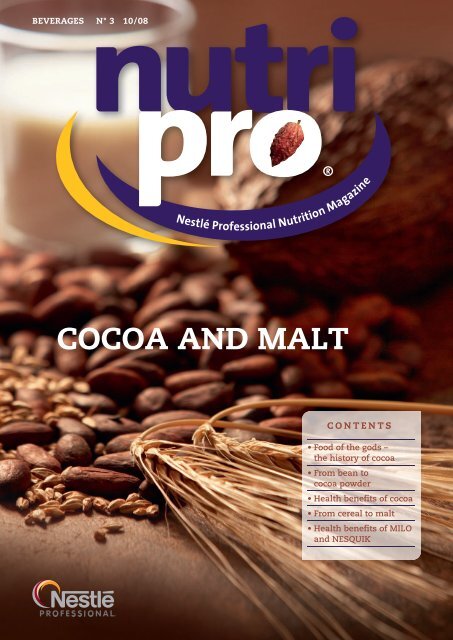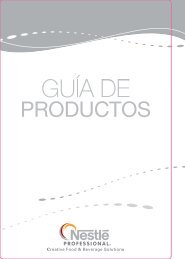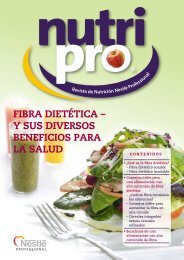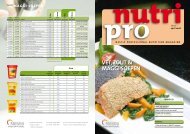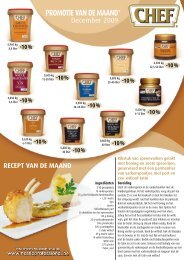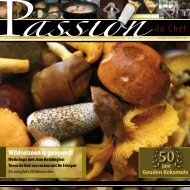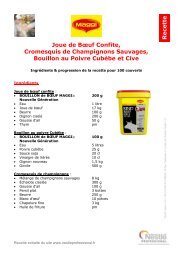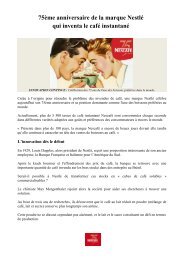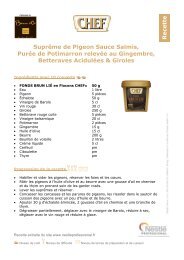CoCoA And MALt - Nestlé Professional
CoCoA And MALt - Nestlé Professional
CoCoA And MALt - Nestlé Professional
Create successful ePaper yourself
Turn your PDF publications into a flip-book with our unique Google optimized e-Paper software.
BEVERAGES n° 3 10/08<br />
<strong>CoCoA</strong> <strong>And</strong> <strong>MALt</strong><br />
ContEntS<br />
• food of the gods –<br />
the history of cocoa<br />
• from bean to<br />
cocoa powder<br />
• Health benefits of cocoa<br />
• from cereal to malt<br />
• Health benefits of MIlo<br />
and nESQUIK
2<br />
CoCoa and Malt<br />
EdItorIal<br />
Dear All<br />
In the past, cocoa – “the food of<br />
the gods” – was a drink used<br />
only for religious rituals and by<br />
the elite. Now, every year more<br />
and more people consume cocoa products like<br />
NESQUIK and MILO. As a result, the worldwide<br />
consumption of cocoa increases at an annual rate<br />
of 2.2 %. The reasons are not only the delicious<br />
taste of these products but also the health benefits<br />
that they provide. More information about the<br />
products and the health benefits is given in this<br />
edition of NutriPro.<br />
We hope you will find the contents of this edition of<br />
NutriPro an enriching reading experience.<br />
Werner Bauer, Executive Vice President<br />
Chief Technology Officer<br />
Dear Reader<br />
Most of us have grown up enjoying<br />
NESQUIK or MILO on a<br />
daily basis – reaping the benefit<br />
of not only the milk added to<br />
these drinks but also of cocoa with its valuable<br />
minerals and vitamins. Both are good for our<br />
health, with cocoa powder being a good source of<br />
polyphenols, especially flavonoids. Some studies<br />
show that these ingredients are likely to have a<br />
positive effect on blood pressure and blood cholesterol<br />
levels. As a result, cocoa may protect against<br />
cardiovascular disease.<br />
This edition offers more information on the cocoa<br />
powder and malt used in NESQUIK and MILO, i.e.<br />
their production, ingredients and health benefits.<br />
Sascha Türler-Inderbitzin, NESTLÉ PROFESSIONAL<br />
Strategic Business Division<br />
NutriPro Beverages 10/08<br />
Food of the gods –<br />
the history of cocoa<br />
from its early origins in South america to today, the cocoa bean<br />
has been enriching the life of people throughout the world. While<br />
the exact origin of both the word “cocoa” and the practice of using<br />
cocoa beans to make chocolate drinks is still controversial, it is<br />
well established that the Mayans and aztecs had developed successful<br />
methods for cultivating cocoa.<br />
Cocoa was a symbol of abundance, and cocoa drinks, originally<br />
destined for the elite only in South America, were used in religious<br />
rituals. To prepare these drinks, cocoa beans were crushed, mixed<br />
with water and laced with spices, chillies and herbs to offset the<br />
bitter taste. During the 16th century cocoa made its way to Europe.<br />
Christopher Columbus was the first European to drink it and the<br />
Spanish conquistador Don Hernán Cortés brought it to Spain. In<br />
1657 a Frenchman in London opened the first “chocolate house”.<br />
The first cocoa powder machines were developed in the Netherlands<br />
(1828) by Coenraad Johannes van Houten. In 1753 the Swedish<br />
natural scientist Carolus Linnaeus gave the cacao plant its<br />
botanical name, calling it “Theobroma (food of the gods) cacao L”.<br />
the cocoa beans<br />
The four main varieties of cocoa beans are:<br />
1. Criollo<br />
• The rarest and finest cocoa variety, it is sometimes called “the<br />
prince of cocoas”. Today it is found only in the oldest of plantations<br />
in Mexico, Columbia and Venezuela.<br />
• Slightly bitter and more aromatic than other varieties, it has an<br />
exceptionally mild and refined flavour that can be compared to<br />
that of Arabica coffee. After processing, the taste of the aromatic<br />
powder combines both strength and delicacy.<br />
2. Forastero<br />
• These beans are bitter, sometimes extremely so, and offer a<br />
limited range of (strong) flavours.<br />
• They have a higher fat content and contain more antioxidants<br />
than criollo beans.<br />
• It is the most popular variety (approximately 80% of the world’s<br />
cocoa harvest).<br />
3. trinitario<br />
• This is a hybrid cocoa plant, created by crossbreeding the two<br />
previous varieties.<br />
• The beans vary greatly in taste but are generally marked by a<br />
good, aromatic flavour.<br />
4. nacional<br />
• Grown only in Ecuador, these beans are renowned for their<br />
“arriba” flavour (floral & spicy) after short fermentation (~3 days).
Cocoa producers – world chart<br />
Cacao trees – small evergreen trees native to the tropical rain forest<br />
region of the Americas – will only grow in a limited geographical zone,<br />
within approximately 20 degrees to the north and south of the equa-<br />
tor. Today, West Africa supplies nearly 70% of the world crop.<br />
Ecuador<br />
Brazil<br />
Global cocoa bean production in 1000t<br />
Sources: ICCO, USDA, FAO, LMC<br />
2005/06 2006/07 (forecast)<br />
world 3731 3388<br />
Africa 2666 2347<br />
Americas 439 431<br />
Asia/Oceania 626 610<br />
Africa<br />
West Africa (WA)<br />
Cameroon 173 175<br />
Côte d’Ivoire 1519 1380<br />
Ghana 740 582<br />
Nigeria 190 165<br />
Subtotal (W/A) 2622 2302<br />
Other Africa 44 45<br />
total Africa 2666 2347<br />
Americas<br />
Brazil 162 145<br />
Ecuador 115 120<br />
Other America 162 166<br />
total Americas 439 431<br />
Asia/oceania<br />
Indonesia 520 500<br />
Malaysia 27 28<br />
Other Asia 79 82<br />
total Asia 626 610<br />
Ghana<br />
Côte d’Ivoire<br />
Cocoa Production Statistics<br />
nigeria<br />
NutriPro Beverages 10/08 – NESTLÉ ProfESSioNaL Nutrition Magazine<br />
Cameroon Malaysia<br />
Indonesia<br />
Ingredients of a cocoa bean<br />
54% Cocoa butter<br />
8 – 13% Polyphenols<br />
11.5% Protein<br />
9% Fibre<br />
7.5% Starch<br />
5% Water<br />
2.6% Minerals<br />
2% Organic acids<br />
1.8 – 2.7% Theobromine<br />
1% Sugar<br />
0.2% Caffeine<br />
Good to know<br />
Curious cocoa<br />
• The Aztec and Mayan societies<br />
used cocoa beans as a local<br />
currency, e.g. one rabbit cost ten<br />
beans, a slave one hundred.<br />
• Ritualistic imbibing of the cocoa<br />
drink was the privilege of men<br />
only, as cocoa was believed to be<br />
toxic for women and children.<br />
• History offers examples of cocoa<br />
being used as a medicine, for<br />
instance by Cardinal Richelieu,<br />
who took drinking cocoa to treat<br />
his enlarged spleen.<br />
• In the first chocolate house in the<br />
UK, guests had to pay 10 to 15 shillings<br />
per pound of chocolate, or<br />
the equivalent of a new musket.<br />
3<br />
Capricorn<br />
0°<br />
Cancer
4<br />
CoCoa and Malt<br />
Good to know<br />
Hot cocoa or<br />
hot chocolate?<br />
Some people use the terms hot<br />
chocolate and hot cocoa synonymously<br />
but, more accurately, they<br />
are two different beverages. Hot<br />
cocoa is made from a mix of cocoa<br />
powder (sometimes in instant<br />
form), sugar and milk or water.<br />
By contrast, hot chocolate is made<br />
directly from chocolate bars (dark,<br />
semisweet or bittersweet chocolate),<br />
which already contain cocoa,<br />
sugar and cocoa butter. Thus the<br />
major difference between the two<br />
is the cocoa butter, which makes<br />
hot cocoa lower in fat than hot<br />
chocolate.<br />
Good to know<br />
Cocoa butter<br />
Cocoa butter, also called theobroma<br />
oil, is a pale yellow fat composed<br />
of particular fatty acids<br />
(around 36% monosaturated). It is<br />
one of the most stable fats because<br />
it contains natural antioxidants<br />
(e.g. vitamin E) that reduce rancidity<br />
and allow for a storage life of<br />
2 – 5 years. Furthermore, it has a<br />
mild chocolaty flavour and aroma,<br />
so it is an important ingredient in<br />
chocolate. Outside the food sector<br />
cocoa butter is used in cosmetic<br />
products, such as lotions, lip balms,<br />
shampoos, soaps, as well as pharmaceuticals.<br />
Lotions and oils containing<br />
cocoa butter are often used<br />
in aroma and massage therapy to<br />
promote relaxation and wellbeing.<br />
From bean to cocoa powder<br />
After harvesting, the cocoa fruits are opened and the seeds, after<br />
being extracted, are transported to the fermentation area. The<br />
fermentation is one of the most important post-harvest steps<br />
concerning the quality of the cocoa. During this process, which<br />
includes numerous complex chemical changes in the beans,<br />
the characteristic flavour and colour are developed. The fermen-<br />
tation process lasts from 3 days, as for some Criollo varieties in<br />
Ecuador, to 6 or 7 days for Forastero beans, grown mostly in Brazil<br />
and West Africa.<br />
After fermentation the cocoa beans are dried in order to reduce<br />
their moisture content from about 60% to around 7%. There are<br />
two methods for drying beans – the sun, which yields better<br />
results, and artificial drying.<br />
The next step in producing a high quality cocoa powder is the<br />
roasting process. By roasting the beans, their moisture content<br />
further decreases to about 2% and a lot of the flavour-, aroma-<br />
and colour components are formed. Thereafter, the roasted<br />
beans are broken down and the thin shell is removed, a proce-<br />
dure known as winnowing. The result are cocoa “nibs”, which<br />
incorporate more than 600 different chemical compounds that<br />
are responsible for the flavour and aroma of the final product.<br />
After the nibs are alkalized, they are then ground into so-called<br />
cocoa liquor or cocoa mass, which contains between 53 – 58% of<br />
cocoa butter.<br />
The last step is the pressing process during which cocoa butter<br />
is pressed out of the cocoa mass under high pressure. The end<br />
products are cocoa butter and cocoa powder.<br />
Whole cocoa beans cocoa beans crushed into small pieces for processing<br />
NutriPro Beverages 10/08
Cocoa powder is not the same<br />
Each manufacturer supplies their own type of powder, with a<br />
specific fat content and pH-value (degree of acidity) as well as a<br />
distinctive colour and aroma.<br />
Based on the fat content, cocoa powder can be classified into<br />
three categories:<br />
1. Cocoa with 20 – 22% cocoa butter<br />
This type can be used in beverages for sensory reasons,<br />
e.g. more mouth-coating and mouth-feel.<br />
2. Cocoa with 10 – 12% cocoa butter<br />
This is the standard powder used in <strong>Nestlé</strong> beverages,<br />
e.g. NESQUIK, NESCAU or MILO.<br />
3. Cocoa with 0% cocoa butter<br />
Predominantly beverage manufacturers may use this type to<br />
alter certain properties of the powder, e.g. to improve its wetta-<br />
bility and solubility.<br />
Beyond beverages, cocoa powder is used as an ideal flavouring<br />
agent in products such as ice cream, bread spreads, dairy prod-<br />
ucts, biscuits and sweets. It adds colour as well as flavour.<br />
Depending on the manufacturing process and the degree of acid-<br />
ity, the colour of cocoa powder may vary from light orange-yel-<br />
low to dark reddish brown.<br />
Cocoa and Malt<br />
cocoa liquor cocoa butter cocoa powder<br />
NutriPro Beverages 10/08 – NESTLÉ ProfESSioNaL Nutrition Magazine<br />
Good to know<br />
History of nESQUIK<br />
NESQUIK was developed in the<br />
USA in 1948 and introduced there<br />
as <strong>Nestlé</strong> Quik. The ingredients<br />
were cocoa powder and flavours<br />
such as cinnamon and vanilla, and<br />
in 2004 vitamins and minerals<br />
were added as well. In the 1950s it<br />
was launched in Europe as<br />
NESQUIK. In 1959 strawberry-flavoured<br />
powder was introduced and<br />
is still available, along with other<br />
flavours such as banana and vanilla.<br />
In 1973 the Quik Bunny – now<br />
known as Quicky the NESQUIK<br />
Bunny – was created. At first he<br />
was adorned with a large blue “Q”<br />
on a collar-like necklace, but since<br />
2004 he flaunts “cooler” attributes<br />
which better express the values<br />
and modernity of the brand. In 1999<br />
the brand name in all countries<br />
was changed to NESQUIK to develop<br />
worldwide recognition. During<br />
the past few years low sugar and<br />
sugar-free varieties were introduced<br />
in the USA, Germany and<br />
Canada.<br />
5
6<br />
CoCoa and Malt<br />
Good to REMEMBER<br />
Caffeine and theobromine<br />
in beverages<br />
Beverages Caffeine theobromine<br />
(range per cup) (range per cup)<br />
Coffee 60 – 180 mg –<br />
Cocoa 6 – 42 mg 200 – 300 mg<br />
Green tea 20 – 110 mg < 3 mg<br />
amount of polyphenols<br />
in different beverages<br />
(mg/glass or cup)<br />
Red wine:<br />
200 – 800mg<br />
Cocoa:<br />
150 – 200mg<br />
NutriPro Beverages 10/08<br />
Green tea:<br />
150 – 200mg<br />
Coffee:<br />
150 – 550mg<br />
Health benefits of cocoa<br />
alexander von Humboldt once stated about cocoa: “nowhere<br />
else has nature compressed such a store of the most valuable<br />
nutrients into such a small space as it has with the cocoa bean.”<br />
Cocoa powder is a good source of:<br />
Minerals, especially:<br />
• Magnesium<br />
This mineral is essential for effective nerve and<br />
muscle function. Furthermore, the organism<br />
needs magnesium to convert nutrients into<br />
energy. It promotes the absorption of calcium<br />
(vital for proper bone structure) and vitamin C.<br />
• Phosphorus<br />
Phosphorus supports energy generation in body<br />
cells and is important – together with calcium –<br />
for forming hard mineral crystals in bones and<br />
teeth.<br />
the health benefits of flavonoids<br />
More than 4,000 flavonoids have been identified and there may<br />
well be many more yet to be discovered. They can be divided into<br />
various subclasses and are credited with being, among other<br />
things: anti-inflammatory, anti-carcinogenic, anti-microbial and<br />
anti-allergic. They are also potent antioxidants – some are even<br />
more powerful than vitamin C or vitamin E – that help to protect<br />
cells from damage caused by an excess of free radicals. Cocoa is<br />
particularly rich in flavanols a subclass of flavonoids. More spe-
fibre<br />
The average amount of fibre in cocoa beans is<br />
comparable to that in whole wheat bread.<br />
Together with cocoa butter, fibre accounts for the<br />
slow absorption of glucose and thereby reduces<br />
fluctuations in blood glucose levels (important for<br />
glucose control).<br />
Polyphenols<br />
alkaloids<br />
Cocoa contains caffeine, but in much lower concentrations<br />
than coffee beans. The most relevant<br />
alkaloid in cocoa is theobromine, which has a<br />
similar effect as caffeine but is about 10 times<br />
weaker and does not markedly affect the central<br />
nervous system. Theobromine is mildly diuretic<br />
(increases urine production) and relaxes the<br />
smooth muscles of the bronchi in the lungs.<br />
About 8 – 13% of the cocoa bean is made up of<br />
polyphenols, a group of phytochemicals. The production<br />
process of cocoa, such as fermentation,<br />
roasting and alkalisation, reduces the overall<br />
polyphenol content. The polyphenols in cocoa<br />
are a subgroup of phytochemicals which include<br />
“flavonoids”.<br />
cifically, it is rich in epicatechin and catechin. As a result, cocoa<br />
consumption is, for instance, inversely associated with blood<br />
pressure, has significant antiplatelet effects and reduces<br />
inflammation generally in the body. Furthermore, it has been<br />
shown that cocoa polyphenols increase HDL cholesterol and<br />
protect against LDL oxidation, so they exert a positive overall<br />
effect on blood cholesterol. The result of all these activities is<br />
that cocoa and its polyphenols may be protective against cardiovascular<br />
disease.<br />
NutriPro Beverages 10/08 – NESTLÉ ProfESSioNaL Nutrition Magazine<br />
Hydroxycinnamates<br />
Flavonols<br />
Cocoa and Malt<br />
Good to know<br />
Phytochemicals<br />
The term phytochemicals refers to<br />
thousands of biologically active<br />
chemical compounds found in<br />
plants, that serve specific beneficial<br />
functions. By extension, absorbing<br />
phytochemicals with<br />
our food can have many positive<br />
effects in the human body; some<br />
are antioxidant, some help to lower<br />
blood cholesterol – a major risk<br />
factor for cardiovascular disease –<br />
and some are protective against<br />
cancer. Most natural foods contain<br />
phytochemicals, especially vegetables,<br />
fruits and herbs. A good way<br />
to ensure ingesting a variety of<br />
these compounds is to choose<br />
foods of every colour of the rainbow.<br />
Anthocyanins<br />
Catechin<br />
Phytochemicals<br />
Polyphenols<br />
Flavonoids<br />
Flavanols<br />
Epicatechin<br />
Isoflavones<br />
Flavanones,<br />
flavones<br />
7
8<br />
CoCoa and Malt<br />
Good to know<br />
What is malt extract?<br />
Malt extract is a concentrated<br />
extract of:<br />
100% malted cereal, usually barley<br />
or sorghum<br />
Bran<br />
Insoluble dietary fibre;<br />
hemicellulose; cellulose;<br />
lignin<br />
Aleurone layer<br />
Dietary fibre; sugars;<br />
protein; lipids;<br />
polyphenols<br />
Endosperm<br />
Starch, protein,<br />
dietary fibre<br />
Germ<br />
Sugars; protein; lipids;<br />
minerals;<br />
polyphenols<br />
From cereal to malt<br />
the preferred cereal for making malt extract is barley. the main<br />
reason is its high starch content, but it is also a good source of<br />
vitamins and minerals.<br />
the process for producing malt extract involves two stages:<br />
a) Malting<br />
b) Malt extract manufacturing.<br />
the first stage – malting – comprises three steps:<br />
a) Steeping: In this step barley is soaked in water to stimulate the<br />
conditions that start germination or growth. It typically takes<br />
between 12 to 24 hours during which the water is changed one<br />
or two times. At the end, the barley will contain approximately<br />
38 – 40% moisture.<br />
b) Germination: During this phase different groups of enzymes<br />
are produced which are necessary for subsequent processing.<br />
The changes taking place during germination are called “mod-<br />
ification”.<br />
c) Kilning: During this final step of the malting process, water is<br />
extracted from the malt which, at this point, is known as<br />
“green malt”, having a moisture content of around 10%. When<br />
drying the malt, the kilning temperature is increased so that<br />
the malt develops colour and flavour. By the end of kilning, the<br />
malt will have a moisture content of 4 – 5%.<br />
dried barley plant barley seeds malted barley malt extract<br />
NutriPro Beverages 10/08
The next step is manufacturing the malt extract, starting with<br />
cleaning the malt. Subsequently, the whole malted grains are<br />
crushed to produce a grist and mixed with hot water in a mash<br />
tun. The malt enzymes, which developed during germination,<br />
convert the starch into sugar, which dissolves in the water.<br />
Finally, the liquid, called “wort”, is separated from the remaining<br />
malt husk and rapidly concentrated into a viscous liquid – the<br />
malt extract.<br />
MILO contains Protomalt ® , a proprietary malt extract with a specific<br />
carbohydrates profile with reduced amount of simple sugars.<br />
This trademarked malt is used in the production of MILO.<br />
NutriPro Beverages 10/08 – NESTLÉ ProfESSioNaL Nutrition Magazine<br />
Cocoa and Malt<br />
Good to know<br />
History of MIlo<br />
MILO was developed by Thomas<br />
Mayne in 1934 in Australia.<br />
The name derives from MILON, a<br />
Roman athlete from Crotona.<br />
At the Pythian Games in Greece,<br />
around 600 B.C., Milon became<br />
famous for his strength.<br />
In 2002 MILO was fortified with<br />
ACTIGEN-E (a unique combination<br />
of 8 vitamins and 4 minerals).<br />
Normally added to milk or water,<br />
it can be served hot or cold. MILO<br />
is also enjoyed in various other<br />
ways across markets and forms a<br />
strong component of good nutrition,<br />
health and wellness.<br />
Over the years, the MILO brand has<br />
developed and been associated<br />
with energy and good health for<br />
active lifestyle.<br />
MILO liquid concentrate is a specific<br />
liquid product, created for operator<br />
to ensure consistent taste when<br />
dispensed cold, and mostly used<br />
by quick service restaurants.<br />
9
10<br />
CoCoa and Malt<br />
Good to REMEMBER<br />
Health benefits of milk<br />
Milk is one of the most nutrientdense<br />
foods, consisting of a unique<br />
blend of carbohydrates, proteins,<br />
fats, vitamins and minerals. Consuming<br />
at least 3 servings of milk<br />
or milk products per day can have<br />
a positive impact on health and<br />
disease prevention. Research has<br />
found that milk and milk products<br />
are important in the prevention of<br />
osteoporosis, in reducing the risk<br />
of cardiovascular disease, colon<br />
cancer and insulin resistance (diabetes),<br />
and in facilitating weight<br />
management.<br />
nutrient<br />
Energy<br />
Protein<br />
Fat, total<br />
Carbohydrates<br />
Calcium<br />
Iron<br />
Vitamin B 1<br />
Vitamin B 2<br />
nUtRIEnt PRoFILE oF MILo<br />
Units<br />
kcal<br />
kj<br />
g<br />
g<br />
g<br />
mg<br />
mg<br />
mg<br />
mg<br />
Example based on MILO powder, Australia<br />
NutriPro Beverages 10/08<br />
average quantity per<br />
20g serving with 200ml<br />
reduced fat milk (1.4%)<br />
184.0<br />
770.0<br />
10.6<br />
4.8<br />
24.1<br />
400.0<br />
6.0<br />
0.6<br />
0.6<br />
Health benefits of MILo<br />
and nESQUIk<br />
MIlo and nESQUIK are nutritious drinks containing many<br />
valuable minerals and vitamins.<br />
They are a very good source of:<br />
Calcium<br />
Calcium is the most common mineral in the body.<br />
It is essential for bone growth and development as<br />
well as for building and maintaining strong teeth.<br />
Furthermore, calcium is involved in a number of<br />
biological processes such as nerve function, muscle<br />
contraction and blood clotting. Especially for<br />
growing children and adolescents it is essential to<br />
get enough calcium for proper bone growth.<br />
average quantity per<br />
10g serving with 200ml<br />
skim milk (0.1%)<br />
143.0<br />
600.0<br />
10.0<br />
2.2<br />
23.5<br />
400.0<br />
6.0<br />
0.6<br />
0.6<br />
* based on a 2000 kcal diet<br />
Iron<br />
Iron is a constituent of haemoglobin, which delivers<br />
oxygen to cells, and of myoglobin, which<br />
stores oxygen in muscle tissue. In addition, it is a<br />
cofactor for a number of important enzymes, for<br />
example ones involved in energy production and<br />
the immune system.<br />
Vitamins<br />
Vitamins are necessary cofactors for enzymes.<br />
All of them are needed in energy metabolism,<br />
some for muscle metabolism (especially vitamin<br />
B1 and B6 ), some for forming red blood cells<br />
(especially vitamin B2 ) and one in particular (B12 )<br />
for folate metabolism and nerve function.
Energy<br />
Carbohydrates deliver glucose in our body.<br />
Glucose is the preferred fuel for the brain and can<br />
be stored in the muscles and liver. Carbohydrates<br />
are essential in helping to restore energy levels<br />
for physical and mental activities, e.g. in school,<br />
when consumed at key moments throughout<br />
the day.<br />
nutrient<br />
Energy<br />
Example based on NESQUIK powder, France<br />
Branded active benefits<br />
– A combination of 8 vitamins and<br />
4 minerals<br />
– A combination of energy-releasing<br />
micronutrients for growth and<br />
development<br />
– For stronger bones and teeth<br />
nUtRIEnt PRoFILE oF nESQUIk<br />
Protein<br />
Total carbohydrates<br />
Fat<br />
Sodium<br />
Dietary fibre<br />
Calcium<br />
Magnesium<br />
Phosphorus<br />
Vitamin B 1<br />
Vitamin B 3<br />
Vitamin B 5<br />
Vitamin B 6<br />
Vitamin B 9<br />
Vitamin C<br />
Vitamin D<br />
Vitamin E<br />
Units<br />
kcal<br />
kj<br />
g<br />
g<br />
g<br />
mg<br />
g<br />
mg<br />
mg<br />
mg<br />
mg<br />
mg<br />
mg<br />
mg<br />
µg<br />
mg<br />
µg<br />
mg<br />
15 g of powder<br />
55.0<br />
233.0<br />
0.6<br />
13.0<br />
0.5<br />
47.0<br />
0.8<br />
18.0<br />
21.0<br />
20.0<br />
0.1<br />
2.6<br />
0.3<br />
0.2<br />
30.0<br />
7.1<br />
0.8<br />
1.5<br />
per cup*<br />
152.0<br />
634.0<br />
7.3<br />
22.0<br />
3.7<br />
49.0<br />
0.8<br />
261.0<br />
46.0<br />
210.0<br />
0.2<br />
2.7<br />
1.0<br />
0.3<br />
39.0<br />
11.0<br />
0.8<br />
* 15 g in 200 ml of semi-skimmed milk<br />
NutriPro Beverages 10/08 – NESTLÉ ProfESSioNaL Nutrition Magazine<br />
Cocoa and Malt<br />
QUIZ<br />
1. originally cocoa came from:<br />
B Switzerland<br />
C South America<br />
d North America<br />
2. which variety of cocoa bean is<br />
called “the prince of cocoa”?<br />
o Criollo<br />
L Forastero<br />
M Trinitario<br />
3. How many different chemical<br />
compounds are found in<br />
cocoa nibs?<br />
A 500<br />
C 600<br />
E 700<br />
4. How much cocoa butter does a<br />
cocoa bean contain?<br />
J Around 20%<br />
k Around 37%<br />
o Around 54%<br />
5. what is the fat content of the<br />
standard powder used in<br />
nESQUIk?<br />
C 0%<br />
A 10 – 12%<br />
d 20 – 22%<br />
6. Is nESQUIk a hot cocoa or a hot<br />
chocolate drink?<br />
P Hot cocoa drink<br />
o Hot chocolate drink<br />
7. the fibre in cocoa beans is<br />
necessary for:<br />
A Effective nerve and muscle<br />
function<br />
E Relaxing smooth muscles<br />
o Slow absorption of glucose<br />
8. which is the most relevant<br />
alkaloid in cocoa?<br />
V Caffeine<br />
w Theobromine<br />
9. Cocoa intake is inversely<br />
associated with<br />
B A good sleep<br />
C Diabetes<br />
d Blood pressure<br />
10. which is the most commonly<br />
used cereal for MILo?<br />
E Barley<br />
F Rice<br />
G Quinoa<br />
11. MILo is a good source of:<br />
S Vitamin C<br />
R Calcium<br />
t Folate<br />
1.6 1 2 3 4 5 6 7 8 9 10 11<br />
Answer: cocoa powder<br />
11


